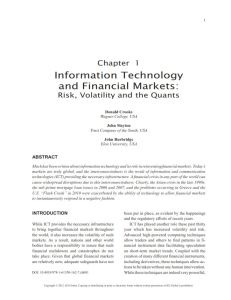Join getAbstract to access the summary!

Join getAbstract to access the summary!
Donald Crooks, John Slayton and John Burbridge
Information Technology and Financial Markets
Risk, Volatility and the Quants
IGI Global, 2012
What's inside?
Information and communication technologies have increased the volatility of financial markets.
Recommendation
Professors Donald Crooks, John Slayton and John Burbridge provide an academic overview of the impact of information and communication technologies (ICT) and quantitative techniques on financial markets. Because they cover so much historical and technological detail in a brief report, they do not address any particular aspect in depth or with particular rigor. That said, this overview does touch on salient points in the development of Wall Street and electronic trading, and puts the ICT revolution in its proper context. getAbstract suggests this pocket history to financial executives and managers, business students who want an introduction to the impact of ICT on markets, and those interested in the past saga and future prospects of securities trading.
Summary
About the Authors
John Slayton is a principal of The Trust Company of the South and an adjunct assistant professor of finance at Elon University, North Carolina, where John Burbridge is a professor of operations and supply chain management. Donald Crooks is an associate professor at Wagner College.



















Comment on this summary